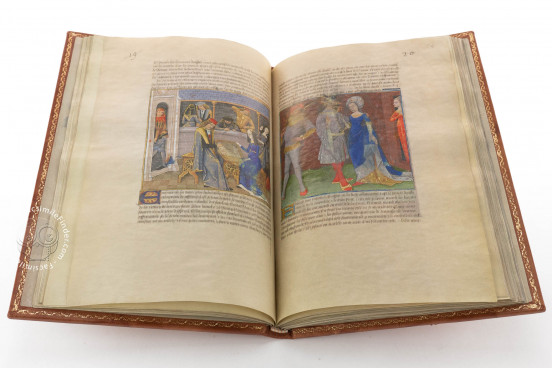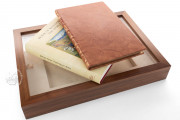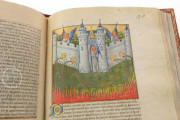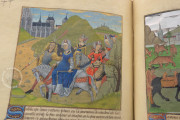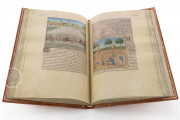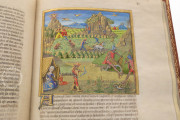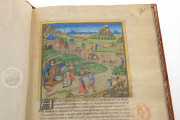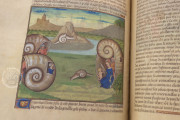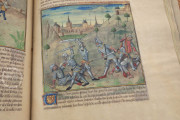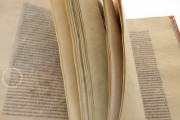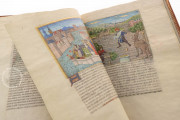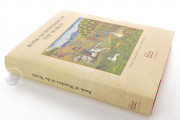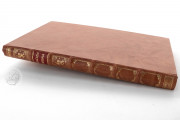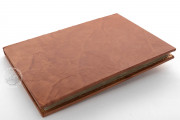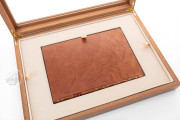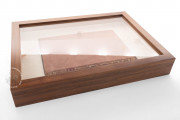During the mid-15th century, Angers stood out as the most brilliant nucleus of French miniature, but towards the end of this century, both that city and great part of the most dynamic miniature centres of western France will suffer a great decline in benefit of Tours that, from then on, will not find a rival by the Loira riverside. The only centre to resist this western artistic decay was the one in Poitiers.
And it is in Poitiers, in this uncertain environment that one of the most original illuminators of the time comes into play: Robinet Testard, an extraordinary artist trained in the stimulating atmosphere which prevailed in western France around the 60s of this century, even though his first artistic steps should be placed around the 70s, if we take into account the date 1471 that appears at the end of the manuscript of Great Chronicles of France, undoubtedly one of his masterpieces.
A True Master of French Miniatures
Besides the chronicles, from the period of Poitiers, in which Testard works on his own, we find dated likewise several Books of Hours by him. Nowadays, we find some of them in New York, Brussels, Besançon, etc., where he offers a clear sample of his special artistic skill. The same applies to the precious missal which is preserved in the treasure of the Poitiers cathedral.
These and many other works give him enough fame to be lucky and be admired and chosen by Carlos de Angulema, bibliophile prince of the house of Orléans and father of the future king of France, Francisco I, who names him chamber painter.
From then on he will not see himself exposed to the insecurity of a pictorial demand in decline, but he will enjoy a stable situation in the Court of Cognac and will work restlessly on the work of his patrons. There is indelible stamp on his works in his particular style, so deeply gothic despite being already at the end of the 15th century.
The Incredible Recreation of the Most Varied Scenes
In the most widely varied contexts, he recreated in mythological and religious scenes, exotic landscapes or admirable botanical figures. He even receives the order to paint the carriage for the funeral of the Count. The young widow, Luisa de Saboya, keeps him at her service and entrusts him with every time more ambitious illuminating programs. Like this, the artist shares the swings of his protector for whom, until 1510, he keeps working.
We will even see how in 1523 he gets benefit, of the generous gifts from the heir of the Angulema, Francisco I, crowned king of France in 1515 and considered the most emblematic monarch in the French Renaissance.
His reign will allow an exceptional development in Arts in France. We will see the name of the artist mentioned for the last time in 1531, on the subsidy attestation and helps from the king to the different members of her recently deceased mother’s house: “Old Robinet, painter…” he will then receive 80 pounds.
The Perfection in the Miniatures
As regards to his style, Testard is, indisputably, an ordinary artist, little concerned with the problems which used to thrill his contemporaries, such as the search for realism and coherent representation of the space following the rules of the scientific prospective updated by the Italians.
His miniatures are of an impeccable and smooth pictorial execution, and their colouring and bright contrast completely remove the third dimension, their figures in little relief are cut out with an almost metallic precision over flat backgrounds similar to a theatre set.
What counts for him is not the illusion of an objective reality, but to transmit the visual message as efficiently as possible. Therefore his insistence on the drawing being stimulated by the discovery he makes of Israel van Meckenem and his German contemporaries. In this aspect, the artist inscribes himself in the best of an antirealist stream with very old roots in both Poitou and Anjou.
The Text at the Service of the Illustrations
The Book of Wonders may be the oldest order that Testard receives since he enters the service of Carlos de Angulema. The text, which intends to be geographical, reviews all the different countries of the world (in alphabetical order) and provides all types of information about them, maybe more fantasized than rigorous, relying on the authority of the Bible, of Plinio el Viejo, of Solino – and his De mirabilibus mundi –, of San Isidoro de Sevilla and of other authors.
It is very likely that this heteroclite compilation intended to fundamentally serve as a base for the images which illustrate the different chapters because, in fact, the limited number of preserved manuscripts that reproduce this text, all of them favour to the illustration and put the text at service. It can also be claimed that Testard’s manuscript is completely independent from its predecessors.
The Art in only Two Dimensions
On its 56 fantastic miniatures we find the particularities which distinguish this author from his contemporaries: simple and flat compositions, at stratified levels and horizons which seem determined to eliminate any glimpse of depth; extraordinary too is the clarity of the outline of the forms. Discrete modulation. His tireless search for clarity covers even the colouring in which the tone contrast makes legibility and well-lit visualisation easy. The tapestry effects obtained by eliminating the third dimension almost completely, matches perfectly with the unreal and mythical character of the text.
The Armony of the Colors
As usual, Testard takes good care of the pictorial execution and stands out like few others in the invention of highly delicate chromatic harmony. In this sense, one of his most elaborate miniatures is the one introducing the chapter of Alto Egipto (f. 16v), that the artist evokes by means of an episode of the life of San Pablo Ermitaño, extracted from the Golden Legend.
The scene is divided in two beaches of different colour, separated by the oblique tracing of a blue river. On close-up, San Antonio interrogates a centaur which indicates the way for him to be reunited with San Pablo.
The characters are enhanced by olive green tones on the land which contrast with the sandy dunes represented aside. It is a delicious scene which can only come from the hand of the great medieval miniature master, of personal features and original technique; all in this manuscript is a beautiful collection of images, some of them of sheer fantasy.
The text is abundant in myth description, at the service of such captivating set of images.
We have 1 facsimile edition of the manuscript "Secrets of the Natural World": Libro de las Maravillas del Mundo facsimile edition, published by Siloé, arte y bibliofilia, 2011
Request Info / Price
